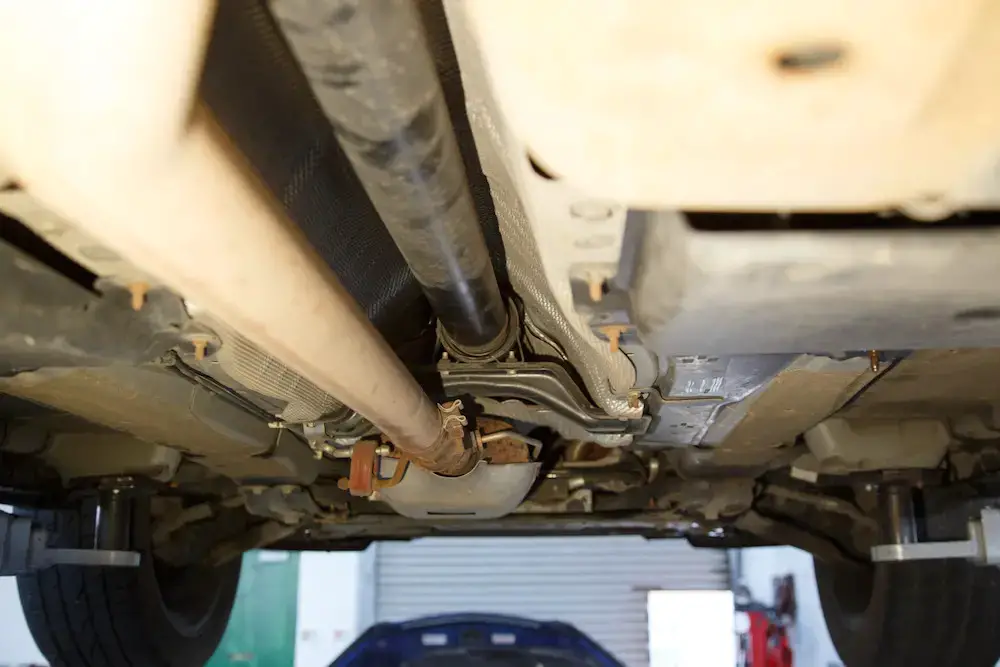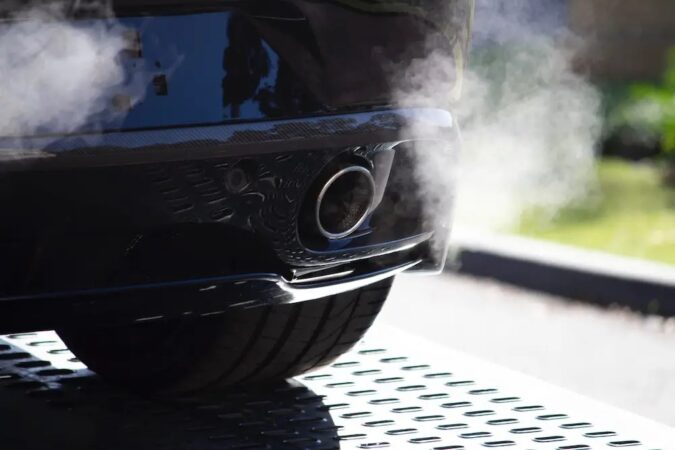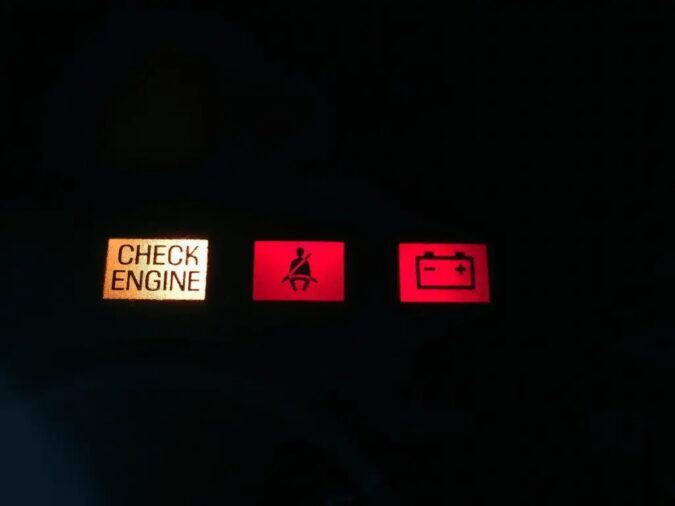The P2270 code is a diagnostic trouble code (DTC) that indicates a problem with the oxygen sensor in the exhaust system of a vehicle. This code is triggered when the engine control module (ECM) detects an issue with the oxygen sensor signal from the exhaust system.
The oxygen sensor is an important part of the exhaust system of a car because it helps keep track of how much air and fuel the engine is using. When the oxygen sensor is not working properly, it can cause problems with the air-to-fuel ratio.
This can lead to a variety of issues, including reduced fuel efficiency, increased emissions, and potentially even engine damage. This ratio needs to be properly balanced (i.e. the best air-fuel ratio) in order for the engine to run efficiently and effectively. That’s why it’s important to address the P2270 code as soon as possible.
This code usually comes with other codes, and it means that there is a problem with the oxygen sensor circuit or the sensor itself. Ignoring this code and driving with a malfunctioning oxygen sensor might result in not just diminished performance and fuel economy but also more significant and costly problems down the road.
P2270 Code
Diagnostic Trouble Codes (DTCs) are stored in a vehicle’s onboard computer when it detects a malfunction in the system. An OBD-II scanner is a device that can be used to read these codes and diagnose problems with the vehicle. OBD-II scanners can be purchased or borrowed from auto parts stores or mechanics.
To use an OBD-II scanner, follow these steps:
- Locate the diagnostic port on the vehicle. This is usually located under the dashboard on the driver’s side.
- Connect the OBD-II scanner to the diagnostic port using the appropriate cable.
- Turn the ignition key to the “on” position (but do not start the engine).
- Follow the instructions on the OBD-II scanner to retrieve the codes.
- The P2270 code, as well as any other stored codes, will be displayed on the scanner.
The P2270 code is just a starting point for diagnosis and is not a definitive solution to the problem. Additional testing and inspection may be needed to thoroughly diagnose and fix the issue.
Causes Of P2270 Code
So, P2270 is a diagnostic trouble code (DTC) for “Oxygen Sensor Signal Biased/Stuck Lean (Bank 1 Sensor 2).” This means that the vehicle’s powertrain control module (PCM) has found a problem with the oxygen sensor circuit on the first bank of cylinders, specifically the sensor at position 2.
For a better understanding of what “bank” and “sensor” location means, we do have plenty of resources that might help. So, check out our write-up on bank 1 sensor 1 and bank 1 sensor 2. Not to mention, our explainer on whether bank 2 sensor 1 is upstream or downstream.
P2270 Causes #1 – Faulty Oxygen Sensor
The oxygen sensor is a crucial component of the vehicle’s emission control system. It is in the tailpipe and measures how much oxygen is in the exhaust gas. If the oxygen sensor is not functioning properly, it may not be able to send the proper signal to the PCM. There are numerous common bad O2 sensor symptoms that you can look for.
If your oxygen sensor is broken, your car might use more gas, have less power, and accelerate slowly. With an OBD scanner, you might be able to easily diagnose if your car has a bad O2 sensor. If you note any of the OBD codes below (among others), then your O2 sensor might be experiencing some issues:
How To Fix A Faulty Oxygen Sensor
There are a few steps you can follow to fix a faulty oxygen (O2) sensor in your car:
- First, you will need to locate the oxygen sensor. It is typically located in the exhaust pipe, near the engine.
- Once you have located the sensor, you will need to remove it. This typically involves using a wrench to loosen and remove the sensor from the exhaust pipe.
- Once the sensor is removed, you may need to purchase a replacement sensor. You can find a replacement sensor at an auto parts store or online.
- Before installing the new sensor, you need to clean the area around the sensor mounting point. This will ensure that the new sensor has a clean surface to mate with proper sealing.
- To install the new sensor, simply reverse the process you used to remove the old one. Use a torque wrench (with some pointers on how to use torque wrench) to make sure the new sensor is securely in place and tightened to the right torque specifications.
- Once the new sensor is installed, start the engine and let it run for a few minutes. This will allow the sensor to warm up and begin working properly.
- Finally, test the sensor to ensure that it is functioning correctly. This can typically be done using a diagnostic tool available at most auto parts stores.
P2270 Causes #2 – Wiring Issues
The oxygen sensor circuit consists of wires that connect the sensor to the PCM (powertrain control module). If there is a problem with these wires, it can disrupt the signal being sent to the PCM. Wiring problems can be caused by a number of things, such as corrosion, loose connections, and physical damage to the wires.
How To Fix Wiring Issues
To diagnose and fix wiring issues causing a P2270 code, it’s important to first check for any visible signs of damage to the wires. This includes checking for frayed or broken wires, as well as any visible corrosion.
If there are no visible issues, the next step is to check for loose connections. This can be done by inspecting the wire connectors for any signs of looseness or disconnection. If the wiring and connections look fine, you may need to use a wiring diagram and a multimeter to test the continuity of the wires.
In so doing, you’re able to figure out if there is a problem with the circuit. It’s important to note that handling wiring issues can be complex and requires a good understanding of electrical systems.
If you are not comfortable with this type of work, it is recommended that you seek the assistance of a trained mechanic. Ignoring problems with the wiring can cause bigger problems down the road or even start a fire in the car.
P2270 Causes #3 – Damaged Fuel System
A fuel system is made up of many parts that can break down over time and cause a lot of trouble. Some of these components that can be damaged include:
1. Clogged Fuel Filters
A clogged fuel filter can restrict the flow of fuel to the engine, causing a lean fuel-to-air ratio. When the fuel-to-air ratio is too lean, it means there is not enough fuel being supplied to the engine for the amount of air that is entering the combustion chamber.
This can cause a number of problems, including reduced engine performance and increased emissions. If the fuel filter is clogged, it will need to be replaced to restore proper fuel flow to the engine. So, make sure you’re on the lookout for the symptoms of a bad fuel filter. And, consider a fuel filter replacement.
2. Faulty Fuel Pump
A faulty fuel pump can also cause an incorrect fuel-to-air ratio in the engine. The fuel pump is responsible for delivering fuel from the fuel tank to the engine. If the fuel pump is not working correctly, it can cause a lack of fuel to be delivered to the engine, resulting in a lean fuel-to-air ratio.
Therefore, you have to be diligent when spotting any symptoms of a bad fuel pump. But, before you consider the outright fuel pump replacement cost, some in-depth diagnosis would help. For instance, the underlying cause might simply be a faulty fuel pump relay.
3. Uneven Fuel Pressure
Incorrect fuel pressure can cause the wrong fuel-to-air ratio in the engine. Fuel pressure is the force with which fuel is delivered to the fuel injectors. If the fuel pressure is too low, it can cause a lean fuel-to-air ratio. Conversely, if the fuel pressure is too high, it can cause a rich fuel-to-air ratio.
In some cases, uneven fuel pressure is due to a bad fuel pressure sensor. That includes a bad fuel rail pressure sensor. You might therefore have to look for symptoms of a bad fuel pressure regulator, or a P0087 code.
4. Damaged Fuel Injectors
Leaking fuel injectors can also cause an incorrect fuel-to-air ratio in the engine. The fuel injectors are in charge of giving the engine the right amount of fuel. If the injectors are leaking, they can cause too much or too little fuel to be delivered, resulting in an incorrect fuel-to-air ratio.
Besides leaks, some of the symptoms of a bad fuel injector include dirty or clogged fuel injectors. In these instances, you don’t have to consider the fuel injector replacement cost just yet. You might even get away with unclogging them with the best fuel injector cleaner (as well as, figuring out how to clean fuel injectors), instead.
P2270 Causes #4 – Faulty PCM
The PCM, or powertrain control module, is a computer that controls the vehicle’s engine and transmission. If the PCM is not functioning properly, it can cause a variety of problems, including the storage of the P2270 code.
You may also have problems with the transmission, such as shifting problems or the transmission slipping, in addition to engine misfires and less power. When the PCM is not working properly, it can have a ripple effect on the rest of the vehicle. If you suspect that your PCM is faulty, it is important to have it checked out by a mechanic.
How To Fix A Faulty PCM
There are a few potential ways to fix a faulty PCM, depending on the specific issue that is causing the problem. Here are a few options:
- Repair the PCM: In some cases, it may be possible to repair the PCM rather than replace it. This can be a cost-effective option, but it will not be possible if the PCM is heavily damaged or if the issue is not able to be easily identified.
- Replace the PCM: If the PCM is not repairable or if the cost of repair is greater than the cost of a replacement, replace the PCM. This can be a complex process, as the PCM is often located in a hard-to-reach area and may require special tools to remove and install.
- Reflash the PCM: In some cases, it may be possible to fix a faulty PCM by “reflashing” the computer. This involves uploading new software to the PCM to overwrite the old software, which can fix any issues that may be causing problems.
It is important to note that attempting to fix a faulty PCM can be a complex and technical task. It is usually best to have a professional mechanic handle the repair or replacement of the PCM to ensure that it is done correctly.
P2270 Causes #5 – Exhaust Leaks
Exhaust leaks can happen anywhere in the exhaust system. They can be caused by corrosion, physical damage, or a broken exhaust part, among other things. Exhaust leaks can cause problems with the oxygen sensor because they allow outside air to enter the exhaust system.
This can make the sensor get wrong readings, and cause the P2270 code to be stored. An exhaust leak sound is characterized by a loud, distinctive noise. If you notice a loud noise coming from under your vehicle or if you smell exhaust fumes inside the cabin, it is important to have the vehicle checked by a mechanic as soon as possible.
How To Fix Exhaust Leaks
Fixing an exhaust leak can be dangerous, as the exhaust system can get very hot. If you are not confident in your ability to repair the leak, it is best to have the work done by a professional mechanic. However, if you wish to proceed, here are some steps to fixing an exhaust leak in your car.
- Identify the location of the leak: The first step in fixing an exhaust leak is to locate where it is coming from. This can be done by listening to the sound of the leak, inspecting the exhaust system visually, or using a smoke machine to identify the location of the leak.
- Determine the cause of the leak: Once the location of the leak has been identified, it is important to determine what is causing the leak. This will help determine the best repair method.
- Clean the area around the leak: Before attempting any repairs, it is important to clean the area around the leak. This will help ensure that the repair material adheres properly and will also help prevent debris from getting into the exhaust system.
- Repair the leak: There are several methods for repairing exhaust leaks, including welding, replacing damaged components, and using sealants. The best method will depend on the location and severity of the leak.
- Test the repair: After the repair has been made, it is important to test the exhaust system to ensure that the leak has been properly fixed. This can be done by starting the engine and listening for any unusual noises or by using a smoke machine to check for leaks.
Preventive Measures To Avoid The P2270 Code
The appearance of this code can be annoying, and it can also cause plans and budgets to change quickly. Hence, to prevent this code from coming up, you can take the below-mentioned measures.
1. Proper Vehicle Maintenance
Make sure that your vehicle is running properly. If your car is misfiring or running poorly, the oxygen sensor might give you the wrong information. Some symptoms of a misfiring engine include a rough idle, poor fuel economy, and a loss of power.
If you suspect that your vehicle is misfiring, you should have it checked by a mechanic as soon as possible. Besides that, an engine misfire can be detected using an OBD scanner, too. So, make sure you look out for misfire-related OBD trouble codes such as:
- P0300 code (including make/brand specific ones like P0300 Chevy or P0300 Nissan)
- P0301 code (cylinder 1 misfire)
- P0302 code (cylinder 2 misfire)
- P0303 code (cylinder 3 misfire)
- P0304 code (cylinder 4 misfire)
- P0305 code
- P0306 code
2. Inspect The Oxygen Sensor On A Regular Basis
Check the oxygen sensor itself for any visible damage or wear. The oxygen sensor is a very important part of the exhaust system. It measures how much oxygen is in the exhaust gas. If the sensor is damaged or worn, it may not be functioning properly. That can cause problems with the engine and the emission control system.
You can inspect the sensor by looking for any visible damage or signs of wear, such as cracks or corrosion. If you find any issues, you should have the sensor replaced by a mechanic.
3. Check For Exhaust Leaks
Exhaust leaks can cause the oxygen sensor to produce incorrect readings. To check for exhaust leaks, listen for any unusual noises coming from the exhaust system, such as hissing or whistling. You can also look for any visible damage to the exhaust pipes or muffler. If you find any issues, you should have them repaired by a mechanic.
Also, check the exhaust system for any blockages or restrictions. These can cause problems with the oxygen sensor. To check the exhaust system, follow the exhaust pipes from the engine to the tailpipe and look for any visible blockages or restrictions.
4. Inspect The Oxygen Sensor And Wiring
If you have recently replaced the oxygen sensor, make sure it is the correct type and properly installed. It is important to use the correct type of oxygen sensor for your vehicle, as different sensors are designed for different engine types and configurations.
Make sure that the sensor is properly installed as well. If the sensor is not installed correctly, it may not function properly. Check the wiring and connections for the oxygen sensor. Any damaged wiring or loose connections can cause the sensor to produce incorrect readings.
To check the wiring and connections, you should locate the sensor and follow the wires that connect it to the vehicle’s electrical system. Look for any visible damage to the wires or any loose connections. If you find any issues, you should have them repaired by a mechanic.
5. Periodically Scan Car Computer For Stored Trouble Codes
Check your vehicle’s computer system for any stored trouble codes or issues. Modern vehicles are equipped with a computer system that stores codes and other diagnostic information when a problem is detected. These codes can help a mechanic diagnose the problem and fix it
6. Check That The Air Filter Is Clean
The air filter is responsible for removing dirt, dust, and other contaminants from the air that enters the engine. If the engine air filter is dirty, it can cause problems with the oxygen sensor.
To check the air filter, locate it in the air intake system (usually under the hood) and inspect it for any visible dirt or debris. If the filter is dirty, you should replace it with a new one. Just bear in mind the cost of a new engine air filter (make sure you’re wary of how much are air filters for cars).
7. Inspect Fuel System
Check the fuel system for any issues. A fuel system problem can cause the engine to run poorly, which can in turn affect the oxygen sensor. To check the fuel system, you will need to inspect the fuel lines, fuel pump, and fuel filter for any visible damage or blockages.
You should also check the fuel pressure to make sure it is within the manufacturer’s specified range.
Last Words On P2270
The P2270 code can be a frustrating and confusing issue for any car owner to deal with. However, it is important to understand the meaning behind this code and take the necessary steps to fix it. The P2270 code indicates a problem with the oxygen sensor circuit in your vehicle, specifically in the bank 1 sensor 1 location.
This can be caused by a variety of issues, such as a faulty oxygen sensor, damaged wiring, or even a problem with the fuel system, etc. It’s important to figure out what’s wrong and fix it as soon as possible since a broken oxygen sensor can make the car use more gas than it should and can even damage the catalytic converter.
If left unchecked, this can lead to even more costly repairs in the long run. To fix the P2270 code, it is recommended to first check the oxygen sensor and any related wiring for damage.
If these aren’t the problems, you may need to have a professional take a closer look at the car and replace the oxygen sensor or fix any other problems that may be going on. Overall, understanding the meaning of the P2270 code and taking the necessary steps to fix it can save you time, money, and hassle in the long run.
It is always best to stay on top of any potential issues with your vehicle to keep it running smoothly and safely.
FAQs About P2270
If you need to learn more about P2270, our FAQs here might help…
How To Clean O2 Sensor
To clean an oxygen sensor, first, remove it from the vehicle and soak it in a mixture of water and a cleaning solution. After allowing it to soak for a few hours, scrub the sensor with a wire brush to remove any built-up dirt or grime. Rinse the sensor well with water, then let it dry completely before putting it back in the car.
What Sensors Can Cause A Car Not To Start
There are several sensors that can cause a car not to start, including the crankshaft position sensor, the camshaft position sensor, the throttle position sensor, and the mass airflow sensor. These sensors provide important information to the car’s engine control unit, and if they are not functioning properly, the car may not start or run correctly.
How To Test O2 Sensor
To test an O2 sensor, you need to locate the sensor, loosen it from the exhaust pipe, connect it to a digital multimeter, and start the engine. Take and compare the readings to manufacturer specifications. If the readings are not within the specified range, the O2 sensor is likely broken and must be replaced.
Where Is The O2 Sensor Located
The exact location of the O2 sensor can vary depending on the make and model of the vehicle, but it is generally located in the exhaust pipe or manifold. In some cases, the exhaust system may have more than one O2 sensor at different places.





